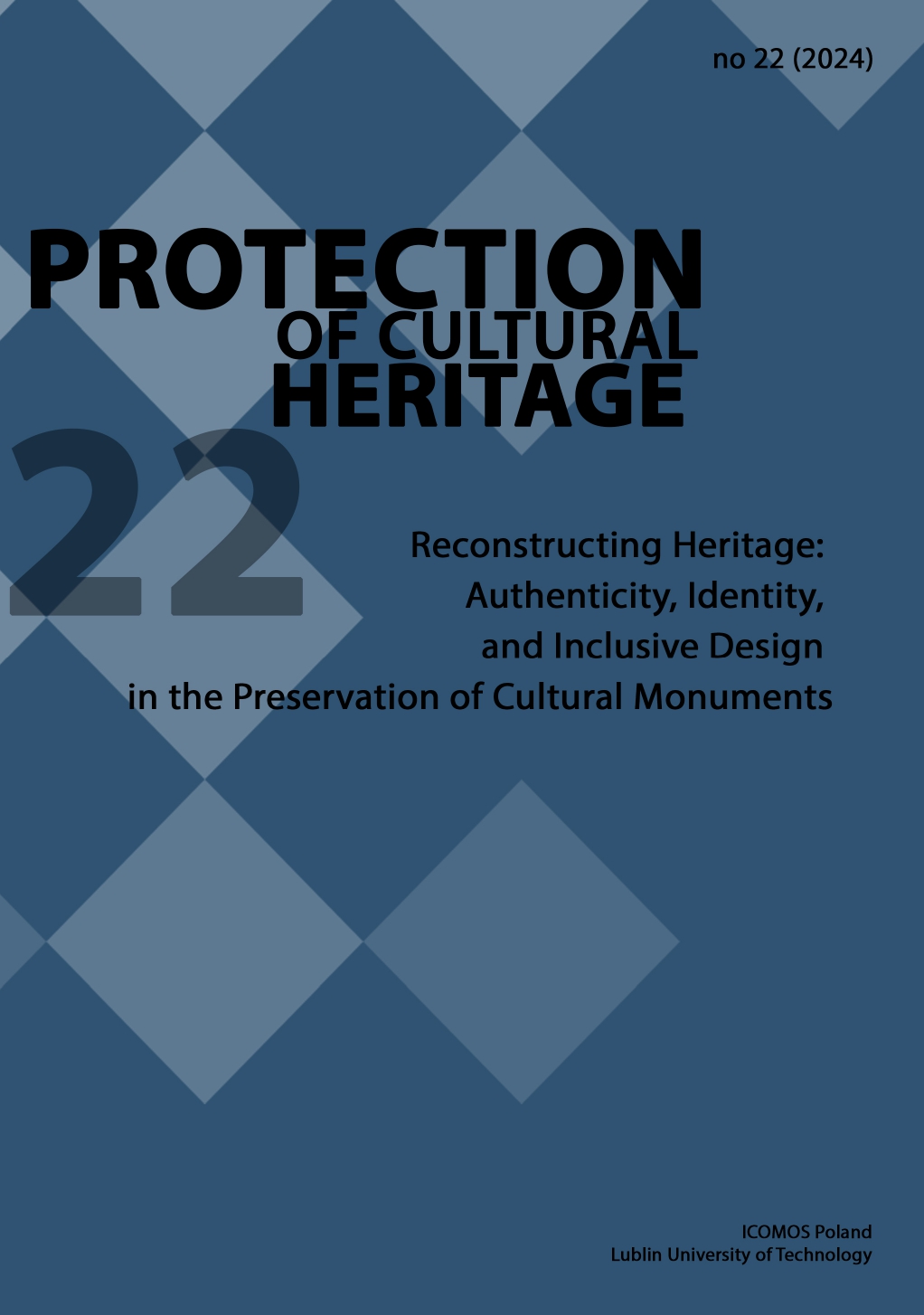Autentyczność dziedzictwa jako źródło jednostkowej i zbiorowej tożsamości
Abstrakt
Dążenie do autentyczności napędza dyskurs na temat dziedzictwa. Artykuł zapewnia kompleksowe spojrzenie na autentyczność dziedzictwa z egzystencjalnego punktu widzenia. Opieram się tu na tekście Mieszkanie, Budowanie i Myślenie Martina Heideggera, który oferuje kontrastujące perspektywy ludzkiej egzystencji w czasie i miejscu: troska i kultywowanie kontra tworzenie i niszczenie. W wyniku tego spojrzenia oczywistym zdaje się, że dziedzictwo ucieleśnia autentyczność, gdy wzmacnia opiekę i kultywowanie wspólnych wartości. Dzięki temu autentyczna troska pozwala dziedzictwu przetrwać i przyczynia się do konstruktywnego rozwoju i zmian adaptacyjnych przy jednoczesnym poszanowaniu ducha miejsca.
Postrzeganie autentyczności dziedzictwa przez pryzmat psychologiczny i filozoficzny podkreśla jego znaczenie w kształtowaniu tożsamości osobistej i zbiorowej. Zrozumienie „innego” jest niezbędne w kształtowaniu naszej tożsamości. Paradoks ten jest również widoczny w dziedzictwie i może być rozwiązany poprzez promowanie bardziej inkluzywnego podejścia, które obejmuje i integruje dziedzictwo innych. Takie podejście podważa konwencjonalne rozumienie wzajemnych relacji między autentycznością dziedzictwa a tożsamością.
Autentyczność i tożsamość zależą od wartości dziedzictwa, wspomnień i wiedzy. Dzięki tej relacji społeczeństwo staje się widoczne dla siebie i innych. Zgodnie z wizją Martina Heideggera i Alessandro Ferrary autentyczna tożsamość wyrażona w dziedzictwie zapewnia cenny wgląd w proces społecznej identyfikacji.
Słowa kluczowe:
autentyczność dziedzictwa, współdzielone wartości, pamięć zbiorowa, tradycyjna wiedza, tożsamośćBibliografia
Audi, R. (2011). Epistemology: A Contemporary Introduction to the Theory of Knowledge, third Kindle ed. New York: Routledge.
Google Scholar
Bozeman, B. (2007). Public Values and Public Interest: Economic Individualism. Washington DC: Georgetown University Press.
Google Scholar
Choay, F. (1992). L’allégorie du patrimoine. Paris: Éditions du Seuil (English translation 2000, The Invention of the Historical Monument. Cambridge UK, Cambridge University Press).
Google Scholar
Council of Europe (2005). Framework Convention on the Value of Cultural Heritage for the Society. https://rm.coe.int/1680083746.
Google Scholar
Ferrara, A. (1998) Reflective Authenticity: Rethinking the Project of Modernity. London: Routledge.
Google Scholar
Hartman, R. S. (1967) The Structure of Value: Foundations of Scientific Axiology, Carbondale, Oregon: Southern Illinois Press.
Google Scholar
Heidegger, M. (1962). Being and Time. Cambridge, USA, Oxford, UK: Blackwell.
Google Scholar
Heidegger, M. (1997). Building, Dwelling, Thinking. In: Leach, N. (ed.) Rethinking Architecture: A Reader in Cultural Theory (94-104). London: Routledge.
Google Scholar
Heynen, H. (2006). Questioning Authenticity. National Identities, 8(3), 287–300. https://doi.org/10.1080/14608940600842607.
Google Scholar
ICOMOS (2008). Quebec Declaration on the Preservation of the Spirit of Place. https://www.icomos.org/images/DOCUMENTS/Charters/GA16_Quebec_Declaration_Final_EN.pdf.
Google Scholar
Jones, S. (2017). Wrestling with the Social Value of Heritage: Problems, dilemmas and opportunities. Journal of Community Archaeology & Heritage 4(1), 21–37.
Google Scholar
Kristinsson, S. (2007). Authenticity, identity, and fidelity to self. In: Rønnow-Rasmussen, T. et al. (eds.) Hommage à Wlodek: Philosophical Papers Dedicated to Wlodek Rabinowicz (1-33). Lund: Department of Philosophy, Lund University, https://www.fil.lu.se/hommageawlodek/site/papper/KristinssonSigurdur.pdf.
Google Scholar
Kolar, T., Kos Koklič, M & Žabkar, V. (2019) Managing sustainable consumption of cultural heritage: the key role of existential authenticity. In: Castelo, A. et al. (eds.) Cultural heritage. (71–84). London, New York: Routledge.
Google Scholar
Logan, W. S. (2007). Closing Pandora’s Box: Human Rights Conundrums in Cultural Heritage Protection. In: H. Silverman & D.F. Ruggles (eds.) Cultural Heritage and Human Rights. (33–52). New York: Springer.
Google Scholar
Munoz Vinas, S. (2005). Contemporary Theory of Conservation. Amsterdam (etc.): Elsevier.
Google Scholar
Munoz Vinas, S. (2009). Beyond Authenticity. Art Conservation and Authenticities: Material, Concept, Context (33-38): London: Archetype.
Google Scholar
Munoz Vinas, S. (2023). A Theory of Cultural Heritage: Beyond the Intangible. Kindle ed., London, New York: Routledge.
Google Scholar
Papmehl-Dufay, L. (2020). Heritage value from below: A local community perspective on conservation, preservation and authenticity in SE Sweden. Cadernos do Lepaarq 17(34), 58-73.
Google Scholar
Pirkovič, J. (2023a), Model of heritage interpretation tailored to public co-participation. Ars & Humanitas 17(1), 251-270, https://journals.unilj.si/arshumanitas/article/view/16008.
Google Scholar
Pirkovič, J. (2023b), Does archaeology deliver evidence about the past or co-create contemporary values? Ars & Humanitas 17(2), 59-77, https://journals.uni-lj.si/arshumanitas/article/view/18165/15362.
Google Scholar
Ryan, R. M., & Deci, E. L. (2019). Brick by brick: The origins, development, and future of self-determination theory. In: Elliot, A. J. (ed.), Advances in Motivation Science (111–156). Amsterdam (et al.): Elsevier Academic Press.
Google Scholar
Silverman, H. (2008). Embodied Heritage, Identity Politics, and Tourism. Anthropology and Humanism, 30, 141–155.
Google Scholar
Smith, L. (2006). Uses of Heritage. London, New York: Routledge.
Google Scholar
Stovel, H. (2007). Effective use of authenticity and integrity as world heritage qualifying conditions. City & Time 2 (3), 21-36.
Google Scholar
Taminiaux, J., & Stevens, J. (1977). Heidegger and Husserl’s “Logical Investigations”: In remembrance of Heidegger’s last seminar (Zähringen, 1973). Research in Phenomenology, 7, 58–83.
Google Scholar
Taylor, C. (1991). The Ethics of Authenticity. Cambridge, Mass., London: Harvard University Press.
Google Scholar
The Nara Document on Authenticity. Drafted in Nara, Japan, with UNESCO, ICCROM and ICOMOS (1994), https://www.icomos.org/en/charters-and-texts/179-articles-en-francais/ressources/charters-and-standards/386-the-nara-document-on-authenticity-1994.
Google Scholar
UNESCO (2003). Convention for the Safeguarding of the Intangible Cultural Heritage. Paris.
Google Scholar
Varga, S. & Guignon, C. (2023). Authenticity In: The Stanford Encyclopaedia of Philosophy, https://plato.stanford.edu/archives/sum2023/entries/authenticity/.
Google Scholar
Wang, N. (1999). Rethinking Authenticity in Tourism Experience. Annals of Tourism Research, 26(2), 349-370.
Google Scholar
Żmudzinska-Nowak, M. & Wałek, M. (2024). Losing Genius Loci in Cultural Heritage Sites – Landscape of Defensive Castle Open-Air Museums of the Jurassic Belt, Poland. Muzeológia a kultúrne dedičstvo, 2024,12(3), 43-62.
Google Scholar
Autorzy
Jelka Pirkovičjelka.pirkovic@guest.arnes.si
University of Ljubljana, New University Słowenia
Statystyki
Abstract views: 48PDF downloads: 35









